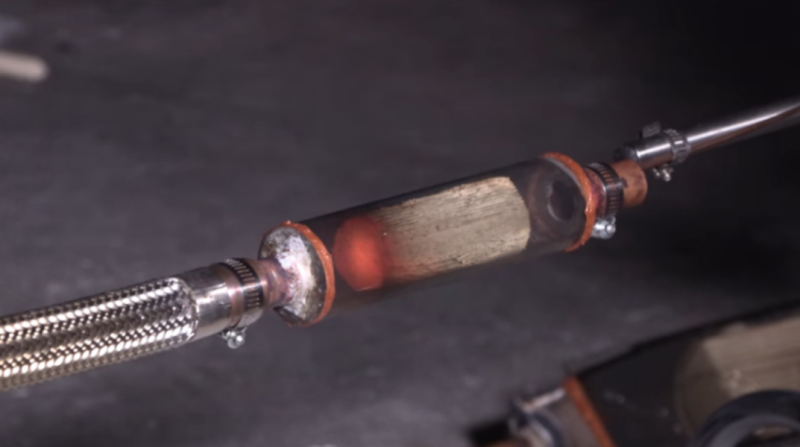There’s always something to be learned from taking things apart. Sometimes the parts can be used for other things, sometimes they can be repaired or improved upon, but sometimes it’s all in good fun. Especially in this case where extremely high temperatures and combustible gasses are involved. This is from the latest video from [Warped Perception] that lets us see inside of a catalytic converter as its operating.
Catalytic converters are installed on most vehicles (and other internal combustion engines) in order to process unburned hydrocarbons from exhaust gasses with a catalyst. These can get extremely hot, and this high temperature complicated the build somewhat. There were two prototypes constructed for this build and the first was a cross-section of a catalytic converter with a glass window sealed on in order to allow the viewing of the catalyst during the operation of a small engine. It was easy to see the dirty exhaust gasses entering and cleaner gasses leaving, but the window eventually blew off. The second was a complete glass tube which worked much better until the fitting on the back finally failed.
A catalytic converter isn’t something we’d normally get to see the inside of, and this video was worth watching just to see one in operation in real life. You could also learn a thing or two about high-temperature fittings as well if you’re so inclined. It might be a nice pairing with another build we’ve seen which gave us a window into a different type of combustion chamber than ones normally found on combustion engines.
Thanks to [Ryoku] for the tip!















You may find catalytic converters in places you hadn’t expected. Our new stove has one about 2.5cm across installed in the oven vent – apparently not uncommon these days – and it works very well at oxidizing smoke and fumes from baking/self-cleaning, though I haven’t checked to see if it glows.
technically speaking it doesn’t HAVE to glow to work (especially with the small volume of gas coming from a stove), all it really needs is the right amount of oxygen.
But it’s a lot more efficient when it’s nice and hot ;-)
Wood stoves have used these for years. Greatly reduces smokes, keeps the chimney cleaner and adds to the heat radiated from the stove.
Vehicles also have air injected before the cat converter. As you might have noticed, the converter didn’t really get hot while running rich until the throttle was closed.
I don’t think so. I haven’t seen any special air injection tubes in any of my cars that have catalytic converters. They just rely on the fact that the exhaust will have oxygen in it sometimes when the ECU hunts for the correct A/F ratio. When the mixture is rich, the cat works as a filter, and when it’s lean it burns the soot off.
Or when you’re slowing down and the ECU cut the fuel input entirely.
“I don’t think so”, well, you should start to do more of that. Go read up on secondary air pumps. Any car built after about 2005 has them and they help to keep the exhaust clean in the first few minutes after a cold start. One of the benefits is that the cat gets to operating temperature a whole lot faster.
So vehicles don’t have air injection – only vehicles built after a certain date do, if they happen to.
Gotcha.
A lot of pre OBD-II vehicles had them too, it went away and came back again. That I’ve personally noticed, 2.8 Litre GM V6es had airpumps, 2.3/2.5 Ford HSC did it with a valve I think.
Heck, my 1973 400 cid Plymouth Fury had air injection. Along with a whole lot of other EPA-mandated crap. Ripped it all out. Mileage went from 13 mpg to 18 mpg. That stupid air pump was actually belt driven. Moronic.
Had one on my 88 rx7
Modern engines use exhaust gas recycling (EGR) and oxygen sensors. Air injection was used before the implementation of the catalytic convertor on passenger cars. Subaru and some other Asian car makers have experimented with it since then, but it is a redundant and unnecessary technique. I have a 2009 Mazda and a 2014 BMW and neither of them have an air injection scheme on them.
You sure as hell would not want to inject air before a hot catalytic convertor. Injecting air before a convertor when it is cold does nothing but condense hydrocarbons in the convertor and confuse the oxygen sensors.
The basic cycling principle you mention is true (for engines with some ECU), but the stuff is wrong. You are talking about a GPF (gasoline particle filter), which works soot particles. A catalytic converter works gases, which are adsorbed for some time if the mixture is too rich.
the ECU toggles between lean and rich, it has to do that for a three-way cat to work both oxidizing CO/HC and reducing NOx
[Warped Perception] maybe a good metal worker, but has a poor understanding of catalytic converters. If you want burn (that is oxidize) unburned fuel, CO (which it hopefully does when he leaves the exhaust gases in his garage) and NO, you need some Oxygen (well that is what does the oxidizing). Rich fuel mixture means less air in relation to fuel than necessary to completely burn the fuel, with fuel=carbon hydrates left over in the exhaust. Running lean means abundance of air (this is the thing with the Oxygen!), which allows to burn something, CO for example. Maybe he wants to ad a lambda sonde and somehow measure the CO content (hackaday staple topic) with and without a catalytic converter.
I was surprised that the glass held up as long as it did.